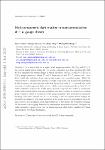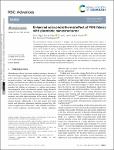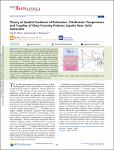Search
Author
- Viet-Thanh Pham (4)
- Tuan Q. Do (3)
- Anh D. Phan (2)
- Chu, Manh Hung (2)
- next >
Subject
- Cosmology and Nongalac... (2)
- General Relativity and... (2)
- Multistability (2)
- 2-NBDG (1)
- next >
Has File(s)
Search Results
The development of spinel ferrite nanomaterial (SFN)-based hybrid architectures has become more popular owing to the fascinating physicochemical properties of SFNs, such as their good electro-optical and catalytic properties, high chemothermal stability, ease of functionalization, and superparamagnetic behaviour. Furthermore, achieving the perfect combination of SFNs and different nanomaterials has promised to open up many unique synergistic effects and advantages. Inspired by the above-mentioned noteworthy properties, numerous and varied applications have been recently developed, such as energy storage in lithium-ion batteries, environmental pollutant monitoring, and, especially, biomedical applications. In this review, recent development efforts relating to SFN-based hybrid design... |
It is shown that for a higher weak isospin symmetry, SU(P)L with P≥3, the baryon minus lepton charge B−L neither commutes nor closes algebraically with SU(P)L similar to the electric charge Q, which all lead to a SU(3)C⊗SU(P)L⊗U(1)X⊗U(1)N gauge completion, where X and N determine Q and B−L, respectively. As a direct result, the neutrinos obtain appropriate masses via a canonical seesaw. While the version with P=3 supplies the schemes of single-component dark matter well established in the literature, we prove in this work that the models with P≥4 provide the novel scenarios of multicomponent dark matter, which contain simultaneously at least P−2 stable candidates, respectively. In this setup, the multicomponet dark matter is nontrivially unified with normal matter by gauge multiplet... |
In this study, silver nanoparticles (AgNPs) were functionalized by various molecules, including sodium borohydride (NaBH4), polyhexamethylene biguanide hydrochloride (PHMB), and Tween 80 to investigate the long-term stabilization of AgNPs in an aqueous dispersion. PHMB-functionalized silver nanoparticles (AgNPs/PHMB) exhibited better stability than others and could be stored at ambient temperature for at least 180 days. In addition to creating stabilization based on the electrostatic repulsion, the use of PHMB helped to increase the degree of stability of the colloidal AgNPs for a long time owing to strong interactions between Ag atoms on AgNPs with nitrogen (N) positions in PHMB molecules. .e formed bond led to improving maintenance ability of the electrostatic repulsion layer amon... |
The photothermal energy conversion in hanging and floating polyaniline (PANi)-cotton fabrics is investigated using a model based on the heat diffusion equation. Perfect absorption and anti-reflection of wet hanging PANi-cotton fabrics cause quick transfer of total incident light into water confining nearly 100% of the sunlight. As a result, a hanging membrane is found to have more attractive properties than a floating above water fabric. We find, however, that the photothermal properties of a floating PANi-cotton membrane can greatly be enhanced by dispersing TiN nanoparticles in the water below the fabric. The calculated temperature gradients for TiN nanoparticle solutions show that the absorbed energy grows with increasing the nanoparticle density and that the photothermal process... |
We employ a new force-level statistical mechanical theory to predict spatial gradients of the structural relaxation time and Tg of polymer liquids near microscopically rough and smooth hard surfaces and contrast the results with vapor interface systems. Repulsive rough (smooth) surfaces induce large slowing down (modest speeding up) of the relaxation time compared to the bulk. Nevertheless, a remarkable degree of universality of distinctive dynamical behaviors is predicted for different polymer chemistries and all interfaces, including a double exponential form of the alpha time gradient, power law decoupling of the relaxation time from its bulk value with exponential spatial variation of the exponent, exponential spatial gradient of Tg, weak dependence of normalized Tg gradients on... |





